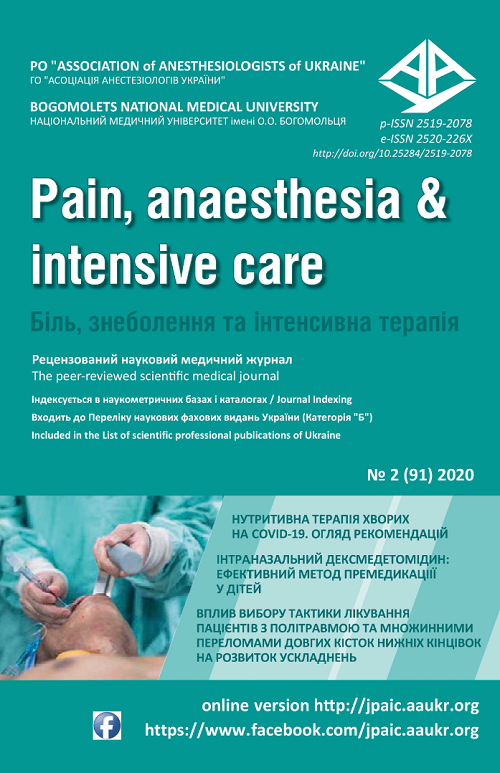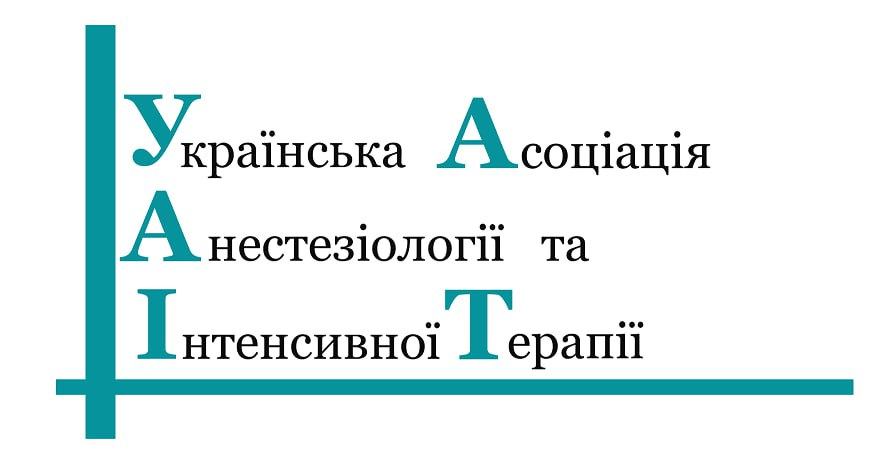ВПЛИВ ВИБОРУ ТАКТИКИ ЛІКУВАННЯ ПАЦІЄНТІВ З ПОЛІТРАВМОЮ ТА МНОЖИННИМИ ПЕРЕЛОМАМИ ДОВГИХ КІСТОК НИЖНІХ КІНЦІВОК НА РОЗВИТОК УСКЛАДНЕНЬ
DOI:
https://doi.org/10.25284/2519-2078.2(91).2020.205603Ключові слова:
політравма, множинні переломи довгих кісток, остеосинтез, ускладненняАнотація
Вступ. Вибір тактики лікування пацієнтів з політравмою та множинними переломами довгих кісток нижніх кінцівок є актуальним та дискусійним питанням сьогодення. Насамперед, це пов’язано з протиріччями щодо вибору терміну та методу первинної та остаточної фіксації переломів.
Мета: визначити вплив застосування запропонованого алгоритму лікування пацієнтів з політравмою та множинними переломами довгих кісток нижніх кінцівок на терміни штучної вентиляції легень (ШВЛ), тривалість лікування пацієнта у відділенні інтенсивної терапії (ВІТ) та лікувальному закладі, частоту розвитку ускладнень та летальність.
Матеріали та методи: з вересня 2016 по лютий 2020 року проведено проспективне контрольоване дослідження, в яке включено повнолітніх пацієнтів із політравмою, Injury Severity Score (ISS) ≥ 18 б, множинними переломами довгих кісток нижніх кінцівок. Пацієнтів розподілено на дві групи: в групу I увійшли пацієнти, які лікувались згідно розробленого алгоритму лікування. В групу II включено пацієнтів, лікування яких виконували згідно з загальноприйнятими заходами діагностики та лікування. Результати: в дослідження включено 95 пацієнтів (в групу І – 43, в групу ІІ – 52). Між пацієнтами порівнюваних груп не було статистично значущих відмінностей за демографічними показниками, механізмом пошкоджень, тяжкістю травми та загального стану пацієнта, кількістю та локалізацією переломів. У пацієнтів групи ІІ, у порівнянні з пацієнтами групи I, визначалась вища частота гострого респіраторного дистрес-синдрому (ГРДС) (19,2% проти 11,6%, p = 0,002), пневмонії (25,0% проти 16,3%, p = 0,007), довші терміни ШВЛ (15,1±9,4 проти 9,6±7,2 діб, p = 0,004), лікування у ВІТ (19,4±12,1 проти 13,7±8,5 діб, p = 0,048) та у лікувальному закладі (38,7±18,9 проти 29,1±15,0 діб, p = 0,023).
Висновки: Ускладнення у пацієнтів з політравмою та множинними переломами довгих кісток нижніх кінцівок є частою причиною гірших результатів лікування, проте застосування диференційного підходу, на основі розробленого алгоритму лікування даної категорії пацієнтів, дозволило зменшити частоту розвитку пневмонії, ГРДС, скоротити терміни ШВЛ, тривалість перебування пацієнтів у ВІТ та лікувальному закладі, без впливу на частоту розвитку фатальної тромбоемболії легеневої артерії, синдрому жирової емболії, сепсису, поліорганної недостатності та летальність.
Посилання
Halvachizadeh, S., Baradaran, L., Cinelli, P., Pfeifer, R., Sprengel, K., & Pape, H. C. (2020). How to detect a polytrauma patient at risk of complications: A validation and database analysis of four published scales. PloS one, 15(1), e0228082. https://doi.org/10.1371/journal.pone.0228082
 |
| 
Toroyan, T., Peden, M. M., & Iaych, K. (2013). WHO launches second global status report on road safety. Injury prevention : journal of the International Society for Child and Adolescent Injury Prevention, 19(2), 150. https://doi.org/10.1136/injuryprev-2013-040775
 |
| 
Probst, C., Pape, H. C., Hildebrand, F., Regel, G., Mahlke, L., Giannoudis, P., Krettek, C., & Grotz, M. R. (2009). 30 years of polytrauma care: An analysis of the change in strategies and results of 4849 cases treated at a single institution. Injury, 40(1), 77–83. https://doi.org/10.1016/j.injury.2008.10.004
 |
| 
Nahm, N. J., & Vallier, H. A. (2012). Timing of definitive treatment of femoral shaft fractures in patients with multiple injuries: a systematic review of randomized and nonrandomized trials. The journal of trauma and acute care surgery, 73(5), 1046–1063. https://doi.org/10.1097/TA.0b013e3182701ded
 |
| 
Liu, X. Y., Jiang, M., Yi, C. L., Bai, X. J., & Hak, D. J. (2016). Early intramedullary nailing for femoral fractures in patients with severe thoracic trauma: A systemic review and meta-analysis. Chinese journal of traumatology = Zhonghua chuang shang za zhi, 19(3), 160–163. https://doi.org/10.1016/j.cjtee.2016.04.001
 |
| 
Cantu, R. V., Graves, S. C., & Spratt, K. F. (2014). In-hospital mortality from femoral shaft fracture depends on the initial delay to fracture fi xation and Injury Severity Score: a retrospective cohort study from the NTDB 2002-2006. The journal of trauma and acute care surgery, 76(6), 1433–1440. https://doi.org/10.1097/TA.0000000000000230
 |
| 
Бур’янов, О. А., Лакша, А. М., Ярмолюк Ю. О. (2013). Сучасні аспекти відновного лікування постраждалих з полісегментарними переломами довгих кісток. Літопис травматології та ортопедії, 3-4, 27-28.
Nicola R. (2013). Early Total Care versus Damage Control: Current Concepts in the Orthopedic Care of Polytrauma Patients. ISRN orthopedics, 2013, 329452. https://doi.org/10.1155/2013/329452
Rotondo, M. F., Schwab, C. W., McGonigal, M. D., Phillips, G. R., 3rd, Fruchterman, T. M., Kauder, D. R., Latenser, B. A., & Angood, P. A. (1993). ‘Damage control’: an approach for improved survival in exsanguinating penetrating abdominal injury. The Journal of trauma, 35(3), 375–383.
 |
|  |
| 
Dong, C., Wang, Y., Wang, Z., Wang, Y., Wu, S., Du, Q., & Wang, A. (2016). Damage Control Orthopedics Management as Vital Procedure in Elderly Patients with Femoral Neck Fractures Complicated with Chronic Renal Failure: A Retrospective Cohort Study. PloS one, 11(5), e0154906. https://doi.org/10.1371/journal.pone.0154906
 |
|  |
| 
Guerado, E., Bertrand, M. L., Cano, J. R., Cerván, A. M., & Galán, A. (2019). Damage control orthopaedics: State of the art. World journal of orthopedics, 10(1), 1–13. https://doi.org/10.5312/wjo.v10.i1.1
 |
|  |
| 
Andruszkow, H., Dowrick, A. S., Frink, M., Zeckey, C., Krettek, C., Hildebrand, F., Edwards, E. R., & Mommsen, P. (2013). Surgical strategies in polytraumatized patients with femoral shaft fractures - comparing a German and an Australian level I trauma centre. Injury, 44(8), 1068–1072. https://doi.org/10.1016/j.injury.2013.03.032
 |
|  |
| 
Vallier, H. A., Moore, T. A., Como, J. J., Wilczewski, P. A., Steinmetz, M. P., Wagner, K. G., Smith, C. E., Wang, X. F., & Dolenc, A. J. (2015). Complications are reduced with a protocol to standardize timing of fi xation based on response to resuscitation. Journal of orthopaedic surgery and research, 10, 155. https://doi.org/10.1186/s13018-015-0298-1
 |
|  |
| 
Bates, P., Parker, P., McFadyen, I., & Pallister, I. (2016). Demystifying damage control in musculoskeletal trauma. Annals of the Royal College of Surgeons of England, 98(5), 291–294. https://doi.org/10.1308/rcsann.2016.0111
 |
|  |
| 
Stahel, P. F., Heyde, C. E., Wyrwich, W., & Ertel, W. (2005). Aktuelle Konzepte des Polytraumamanagements: Von ATLS zu «Damage Control» [Current concepts of polytrauma management: from ATLS to «damage control»]. Der Orthopade, 34(9), 823–836. https://doi.org/10.1007/s00132-005-0842-5
 |
|  |
| 
Harvin, J. A., Harvin, W. H., Camp, E., Caga-Anan, Z., Burgess, A. R., Wade, C. E., Holcomb, J. B., & Cotton, B. A. (2012). Early femur fracture fi xation is associated with a reduction in pulmonary complications and hospital charges: a decade of experience with 1,376 diaphyseal femur fractures. The journal of trauma and acute care surgery, 73(6), 1442– 1449. https://doi.org/10.1097/TA.0b013e3182782696
 |
|  |
| 
Pallister, I, Francis, W.R, Stanley, J.C et al. (2012). Definitive major fracture surgery after damage control & in isolated injuries – a pragmatic approach to timing is safe. J Bone Joint Surg Br; (Suppl 18): 71
Pape, H. C., Lefering, R., Butcher, N., Peitzman, A., Leenen, L., Marzi, I., Lichte, P., Josten, C., Bouillon, B., Schmucker, U., Stahel, P., Giannoudis, P., & Balogh, Z. (2014). The definition of polytrauma revisited: An international consensus process and proposal of the new ‘Berlin defi nition’. The journal of trauma and acute care surgery, 77(5), 780–786. https://doi.org/10.1097/TA.0000000000000453.
 |
|  |
| 
Advanced Trauma Life Support (ATLS) of the American College of Surgeons (ACS), Committee on Trauma. 10th Edition. (2018). 2-420.
Pape, H. C., Giannoudis, P. V., Krettek, C., & Trentz, O. (2005). Timing of fi xation of major fractures in blunt polytrauma: role of conventional indicators in clinical decision making. Journal of orthopaedic trauma, 19(8), 551–562. https://doi.org/10.1097/01.bot.0000161712.87129.80
 |
| 
Rating the severity of tissue damage. I. The abbreviated scale. (1971). JAMA, 215(2), 277–280. https://doi.org/10.1001/jama.1971.03180150059012
 |
| 
Baker, S. P., O’Neill, B., Haddon, W., Jr, & Long, W. B. (1974). The injury severity score: a method for describing patients with multiple injuries and evaluating emergency care. The Journal of trauma, 14(3), 187–196
 |
|  |
| 
Teasdale, G., & Jennett, B. (1974). Assessment of coma and impaired consciousness. A practical scale. Lancet (London, England), 2(7872), 81–84. https://doi.org/10.1016/s0140-6736(74)91639-0
 |
|  |
| 
Meinberg, E. G., Agel, J., Roberts, C. S., Karam, M. D., & Kellam, J. F. (2018). Fracture and Dislocation Classifi cation Compendium-2018. Journal of orthopaedic trauma, 32 Suppl 1, S1–S170. https://doi.org/10.1097/BOT.0000000000001063
 |
|  |
| 
Gustilo, R. B., & Anderson, J. T. (1976). Prevention of infection in the treatment of one thousand and twenty-fi ve open fractures of long bones: retrospective and prospective analyses. The Journal of bone and joint surgery. American volume, 58(4), 453–458
 |
|  |
| 
Gurd, A. R., & Wilson, R. I. (1974). The fat embolism syndrome. The Journal of bone and joint surgery. British volume, 56B(3), 408–416
 |
|  |
| 
ARDS Definition Task Force, Ranieri, V. M., Rubenfeld, G. D., Thompson, B. T., Ferguson, N. D., Caldwell, E., Fan, E., Camporota, L., & Slutsky, A. S. (2012). Acute respiratory distress syndrome: the Berlin Defi nition. JAMA, 307(23), 2526–2533. https://doi.org/10.1001/jama.2012.5669
 |
|  |
| 
Schurink, C., Nieuwenhoven, C., Jacobs, J. A., Rozenberg-Arska, M., Joore, H., Buskens, E., Hoepelman, A., & Bonten, M. (2004). Clinical pulmonary infection score for ventilator-associated pneumonia: accuracy and inter-observer variability. Intensive care medicine, 30(2), 217–224. https://doi.org/10.1007/s00134-003-2018-2
 |
|  |
| 
Singer, M., Deutschman, C. S., Seymour, C. W., Shankar-Hari, M., Annane, D., Bauer, M., Bellomo, R., Bernard, G. R., Chiche, J. D., Coopersmith, C. M., Hotchkiss, R. S., Levy, M. M., Marshall, J. C., Martin, G. S., Opal, S. M., Rubenfeld, G. D., van der Poll, T., Vincent, J. L., & Angus, D. C. (2016). The Third International Consensus Definitions for Sepsis and Septic Shock (Sepsis-3). JAMA, 315(8), 801– 810. https://doi.org/10.1001/jama.2016.0287
 |
|  |
| 
Vincent, J. L., Moreno, R., Takala, J., Willatts, S., De Mendonça, A., Bruining, H., Reinhart, C. K., Suter, P. M., & Thijs, L. G. (1996). The SOFA (Sepsis-related Organ Failure Assessment) score to describe organ dysfunction/failure. On behalf of the Working Group on SepsisRelated Problems of the European Society of Intensive Care Medicine. Intensive care medicine, 22(7), 707–710. https://doi.org/10.1007/bf01709751
 |
|  |
| 
Banerjee, M., Bouillon, B., Shafi zadeh, S., Paffrath, T., Lefering, R., Wafaisade, A., & German Trauma Registry Group (2013). Epidemiology of extremity injuries in multiple trauma patients. Injury, 44(8), 1015–1021. https://doi.org/10.1016/j.injury.2012.12.007
 |
|  |
| 
Kobbe, P., Micansky, F., Lichte, P., Sellei, R. M., Pfeifer, R., Dombroski, D., Lefering, R., Pape, H. C., & TraumaRegister DGU (2013). Increased morbidity and mortality after bilateral femoral shaft fractures: myth or reality in the era of damage control?. Injury, 44(2), 221–225. https://doi.org/10.1016/j.injury.2012.09.011
 |
| 
Lichte, P., Weber, C., Sellei, R. M., Hildebrand, F., Lefering, R., Pape, H. C., Kobbe, P., & TraumaRegister DGU (2014). Are bilateral tibial shaft fractures associated with an increased risk for adverse outcome?. Injury, 45(12), 1985–1989. https://doi.org/10.1016/j.injury.2014.10.005
 |
| 
Blokhuis, T. J., Pape, H. C., & Frölke, J. P. (2017). Timing of definitive fi xation of major long bone fractures: Can fat embolism syndrome be prevented?. Injury, 48 Suppl 1, S3–S6. https://doi.org/10.1016/j.injury.2017.04.015
 |
| 
Nahm, N. J., Moore, T. A., & Vallier, H. A. (2014). Use of two grading systems in determining risks associated with timing of fracture fi xation. The journal of trauma and acute care surgery, 77(2), 268–279. https://doi.org/10.1097/TA.0000000000000283
 |
| 
Pfeifer, R., Rixen, D., Husebye, E. E., Pardini, D., Müller, M., Dumont, C., Oestern, H. G., Giannoudis, P., Pape, H. C., & EPOFF study group (2012). Do stable multiply injured patients with bilateral femur fractures have higher complication rates? An investigation by the EPOFF study group. European journal of trauma and emergency surgery : offi cial publication of the European Trauma Society, 38(2), 185–190. https://doi.org/10.1007/s00068-011-0147-9
 |
| 
Akoh, C. C., Schick, C., Otero, J., & Karam, M. (2014). Fat embolism syndrome after femur fracture fi xation: a case report. The Iowa orthopaedic journal, 34, 55–62.
 |
| 
Silva, J., Diana, D. A., Salas, V., Zamboni, C., Hungria Neto, J. S., & Christian, R. W. (2017). Fat embolism syndrome in femoral shaft fractures: does the initial treatment make a difference?. Revista brasileira de ortopedia, 52(5), 535–537. https://doi.org/10.1016/j.rboe.2016.08.021

DeFroda, S. F., & Klinge, S. A. (2016). Fat Embolism Syndrome With Cerebral Fat Embolism Associated With Long-Bone Fracture. American journal of orthopedics (Belle Mead, N.J.), 45(7), E515–E521.
 |
| 
Berlot, G., Bussani, R., Shafi ei, V., & Zarrillo, N. (2018). Fulminant Cerebral Fat Embolism: Case Description and Review of the Literature. Case reports in critical care, 2018, 7813175. https://doi.org/10.1155/2018/7813175

Engström, J., Reinius, H., Ström, J., Bergström, M. F., Larsson, I. M., Larsson, A., & Borg, T. (2016). Lung complications are common in intensive care treated patients with pelvis fractures: a retrospective cohort study. Scandinavian journal of trauma, resuscitation and emergency medicine, 24, 52. https://doi.org/10.1186/s13049-016-0244-1
 |
| 
van Wessem, K., & Leenen, L. (2018). Incidence of acute respiratory distress syndrome and associated mortality in a polytrauma population. Trauma surgery & acute care open, 3(1), e000232. https://doi.org/10.1136/tsaco-2018-000232
 |
| 
Robba, C., Ortu, A., Bilotta, F., Lombardo, A., Sekhon, M. S., Gallo, F., & Matta, B. F. (2017). Extracorporeal membrane oxygenation for adult respiratory distress syndrome in trauma patients: A case series and systematic literature review. The journal of trauma and acute care surgery, 82(1), 165–173. https://doi.org/10.1097/TA.0000000000001276
 |
| 
Steinhausen, E., Lefering, R., Tjardes, T., Neugebauer, E. A., Bouillon, B., Rixen, D., & Committee on Emergency Medicine, Intensive and Trauma Care (Sektion NIS) of the German Society for Trauma Surgery (DGU) (2014). A risk-adapted approach is benefi cial in the management of bilateral femoral shaft fractures in multiple trauma patients: an analysis based on the trauma registry of the German Trauma Society. The journal of trauma and acute care surgery, 76(5), 1288–1293. https://doi.org/10.1097/TA.0000000000000167
 |
| 
Trancă, S., Petrișor, C., Hagău, N., & Ciuce, C. (2016). Can APACHE II, SOFA, ISS, and RTS Severity Scores be used to Predict Septic Complications in Multiple Trauma Patients?. Journal of critical care medicine (Universitatea de Medicina si Farmacie din Targu-Mures), 2(3), 124–130. https://doi.org/10.1515/jccm-2016-0019

Дубров, С., Сорокіна, О., Дуброва, К., Славута, Г. (2017). Актуальність проблеми сепсису у світі та в Україні. Гострі та невідкладні стани у практиці лікаря, № 4 (67), 32-35.
Shankar-Hari, M., Phillips, G. S., Levy, M. L., Seymour, C. W., Liu, V. X., Deutschman, C. S., Angus, D. C., Rubenfeld, G. D., Singer, M., & Sepsis Defi nitions Task Force (2016). Developing a New Definition and Assessing New Clinical Criteria for Septic Shock: For the Third International Consensus Defi nitions for Sepsis and Septic Shock (Sepsis-3). JAMA, 315(8), 775–787. https://doi.org/10.1001/jama.2016.0289
 |
| 
Vallier, H. A., Cureton, B. A., & Patterson, B. M. (2013). Factors affecting revenue from the management of pelvis and acetabulum fractures. Journal of orthopaedic trauma, 27(5), 267–274. https://doi.org/10.1097/BOT.0b013e318269b2c3
 |
| 
##submission.downloads##
Опубліковано
Як цитувати
Номер
Розділ
Ліцензія
Авторське право (c) 2020 Біль, знеболення та інтенсивна терапія

Ця робота ліцензується відповідно до Creative Commons Attribution-NonCommercial 4.0 International License.
Автори, які публікуються у цьому журналі, погоджуються з наступними умовами:
a. Автори залишають за собою право на авторство своєї роботи та передають журналу право першої публікації цієї роботи на умовах ліцензії Creative Commons Attribution-NonCommercial 4.0 International License, котра дозволяє іншим особам вільно розповсюджувати опубліковану роботу з обов'язковим посиланням на авторів оригінальної роботи та першу публікацію роботи у цьому журналі.
b. Автори мають право укладати самостійні додаткові угоди щодо неексклюзивного розповсюдження роботи у тому вигляді, в якому вона була опублікована цим журналом (наприклад, розміщувати роботу в електронному сховищі установи або публікувати у складі монографії), за умови збереження посилання на першу публікацію роботи у цьому журналі.
c. Політика журналу дозволяє і заохочує розміщення авторами в мережі Інтернет (наприклад, у сховищах установ або на особистих веб-сайтах) рукопису роботи, як до подання цього рукопису до редакції, так і під час його редакційного опрацювання, оскільки це сприяє виникненню продуктивної наукової дискусії та позитивно позначається на оперативності та динаміці цитування опублікованої роботи (див. The Effect of Open Access).








